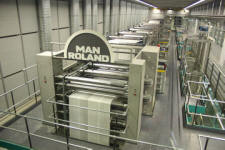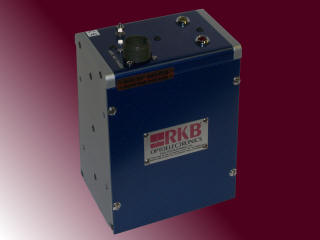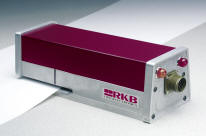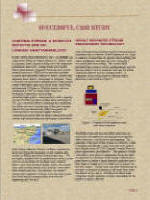|
|
 |
|
TECHNICAL SPECIFICATIONS |
|
Defects Types Detected: |
Splices
Gross Missing Plies
Web Breaks |
|
Material Compatibility: |
Papers
Plastics
Films
Other Non-metallic Materials |
|
Web Thickness: |
5.08 mm Max. (0.20" Max.) |
|
Gap Width: |
6.35 mm (0.25") |
|
Maximum Web Speed: |
No Limit |
|
Minimum Web Speed: |
15.24 meter (50
fpm) |
|
Relay Alarm Outputs:
Dry Output Contact Closures:
Current Capacity at 110 VAC:
Current Capacity at 220 VAC:
Alarm On Period: |
2 (Non-inductive)
0.1 Amp
0.05 Amp
1 Second |
|
Electronic Alarm Output:
Pulse Outputs:
Voltage:
Direction:
Duration:
|
1
15 V (± 3 V)
Positive Going
10 ms |
|
Ambient Temperature: |
4 to 70° C (40
to 160° F) |
|
Dimensions: |
15.24 cm X 19.05 cm x 11.1
cm
(6.0" X 7.5" X 4.37") |
|
Power: |
110/220/240 VAC
50/60 Hz
Single Phase |
|
Specifications are subject to change without notice.
Note: If you web speed is less than 100
fpm, specialized circuitry may have to be applied. If you purchase
this unit and it is found that specialized circuitry is required due to
misinformation, all monies applicable will be charged, then applied as a
credit for replacement of this standard unit with a specialized unit.
Additional fees may be applied. |
 Prevent Costly Repair: Prevent Costly Repair:
The Black
Mamba® Web Press Splice Detector™ & Distribution Technology is to detect the presence of all splices in
the web of paper being processed on a high speed web press and generate
output signals to notify the press print stations that a splice has been
detected. The spacing tolerance between the press print heads or station
is very close and there is potential to damage the print heads/station
by passing a splice through the press when the press is in ready
position. Detection of a splice in the web is critical to allow the
system sufficient time to protect the print heads/station.
In general, the Black Mamba Technology:
|
 |
Reliably
detect splices in the web. |
|
 |
Generate a
signal upon detection of a splice. |
|
 |
Provide a
fail safe mechanism to notify the press system that the
sensor subsystem is connected and functioning. |
Theory of Operation:
Digital signals relative to the common reference is
output from the Black Mamba® Web Press Splice Detector™ &
Distribution Technology and input to the web press
electronics. The signals are used to indicate three states. The three
states represented by the splice signal include the “idle” state, the
“splice detected” state, and the “fault” state.
The idle state is represented by a continuous stream of pulses of a
defined duration called the heartbeat. The splice detect event is
represented by a single pulse of defined duration. The fault state is
represented by a continuous (i.e., not pulsing) signal. The web press
electronics will sample and process incoming pulses to determine whether
it’s a heartbeat, a splice detect event, a combination of both
superimposed on each other in time, or a fault condition. Short pulses
within a defined tolerance of the heartbeat pulse will be interpreted as
a heartbeat. Longer pulses within a defined tolerance will be
interpreted as a splice event. Pulse widths that do not match the
specification will be considered fault conditions. Missing heartbeat
pulses or a static signal state will also be considered a fault
condition. Upon the detection of a "fault" condition the print
heads/station will be retracted allowing the defective paper to pass
uninterrupted by the print station thus protecting the sensitive print
station from damage.
Technology:
The solution is comprised of two
distinct devices including a standard Sentinel® Splice
Detector™ Technology with a physical separate control & distribution cabinet. The
sensor unit detects splices and outputs a pulse to indicate the defect
"fault" event. The pulse is input to the Black Mamba control &
distribution cabinet which combines incoming splice fault signals with a
periodic time based signal ("heartbeat") and control processing
circuitry. The resulting signal is output via a set of cabling and
isolation circuitry to the web press electronics. The processing
circuits in the Black Mamba control & distribution cabinet disables the
heartbeat output if the sensor unit is not "powered on" or the splice
fault signal is not connected. In addition, an option to disable the
"heartbeat" independently for each output channel at field installation
time is supported. In the latter case, splice fault events detected by
the properly connected, powered on, and functioning sensor unit will
exit each channel with or without the "heartbeat" depending on the
installation specific settings.
Functional
Specifications:
All functional specifications are defined at the input
point to the web press electronics. In other words, measured at the
connector on the web press electronics that the splice detect subsystem
plugs into.
|
 |
Output
Ports: The splice detect subsystem shall provide three
connections ports to the web press system. |
|
 |
Electrical
Isolation: Isolation circuitry is required to isolate the
ground (common) reference between the web press electronics
and the splice detect system. The cable length between the
isolation circuitry and the customer electronics shall not
exceed 18 inches. |
|
 |
System
interface diagram. |
|
 |
Web press
electronics receive circuitry load. |
|
 |
Signal
Threshold Specifications: When operating properly the splice
detect signal is normally high and pulses low to indicate a
heartbeat or splice detect event. The web press electronics
are compatible with either an open-drain or active push/pull
driver within specified operating limits. Open drain is
recommended. The web press electronics have an on-board pull
up resistor connected to a DC volt +/- 5% power rail. An
un-biased input will be pulled high and represent a logical
“1”. The splice detect signal is an active low signal. When
asserted, the input voltage shall meet the Vin low
specification in Table 1 below. When de-asserted, the input
voltage shall meet the Vin high specification below. Ability
to adjust the plus durations output from the splice sensor
in the field is desirable. |
|
 |
Signal
Timing Specifications: The signal input to the web press
electronics shall conform to the timing specifications
defined in the manual. |
Benefits:
Each Sentinel®
Splice Detector™ Technology installed provides the end users, as well as the
web press manufacturer the following:
|
 |
100% Reliability in
splice fault detection. |
|
 |
Fail safe to notify
the press that the Black Mamba is connected and functioning. |
|
 |
Cuts down time for
machine maintenance. |
|
 |
Limits emergency
down time caused by damaged print heads/stations. |
|
 |
Eliminates the need
for "SPLICE FREE PAPER" to be required. |
|
 |
Significantly
improves marketability of press sales to end users. |
|
 |
Increases product
quality of both press and printed material. |
 Expect Reliability: Expect Reliability:
With installations in over 130 countries worldwide, our
splice detection technologies have been effectively established to
ensure delivered product superiority on tens of thousands of materials,
coated and non-coated such as papers, films, nonwovens, textiles, and
tapes. Our splice detection technologies are installed on many types of
machinery including sheeters, on and off machine coaters, extrusion
laminators, supercalenders, rotogravure and flexographic printing
presses, holographic processes, textile and nonwoven machinery. Low
speed to high speed, Splice Detector Systems are proven time and time
again to be the leader in performance, reliability and price.
Call SDS:
Call us today to discuss your web inspection application and to
learn more about the industry's most diverse line of machine vision
web inspection, hole detection, splice detection and control
products.
[
TOP PAGE ]
|






 Prevent Costly Repair:
Prevent Costly Repair:
 Expect Reliability:
Expect Reliability: